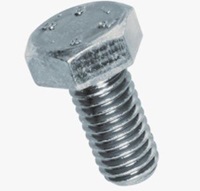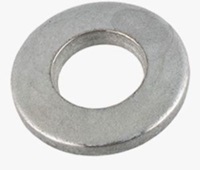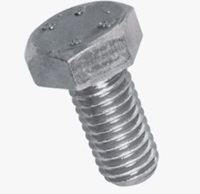Corrosion Protection Coatings
Corrosion protection coatings extend the service life of fasteners by forming a durable barrier against moisture, chemicals, and environmental exposure. Zinc is one of the most widely used and cost-effective coatings for protecting metal fasteners from corrosion. It provides reliable sacrificial protection and a clean, uniform appearance, making it suitable for a broad range of components. There are a few different types of Zinc corrosion-resistant coatings:
Zinc Electroplating with Blue / Yellow / Thick Layer Passivation (CrVI)-free

Zinc electroplating is a versatile and economical coating process that deposits a thin layer of zinc onto metal fasteners to provide sacrificial corrosion protection. The addition of blue, yellow, or thick-layer passivation enhances the coating’s resistance to white rust and extends service life—all without the use of hexavalent chromium (CrVI). This makes it an environmentally responsible option for a wide range of applications.
- Excellent sacrificial corrosion protection
- Available finishes: blue, yellow, or thick-layer passivation
- CrVI-free (hexavalent chromium free) for regulatory compliance
- Uniform, bright appearance suitable for visible assemblies
- Cost-effective for screws, bolts, nuts, washers, studs, and rivets
Mechanical Zinc Plating with Blue / Yellow / Thick Layer Passivation (CrVI)-free

Mechanical zinc plating applies a protective zinc layer without the risk of hydrogen embrittlement, making it ideal for high-strength steel fasteners. Parts are placed in a barrel with proprietary chemicals, zinc powder, and glass beads, then tumbled to mechanically bond the zinc to all exposed surfaces. This CrVI-free coating provides uniform coverage and reliable corrosion protection for components with simple geometries.
- Eliminates hydrogen embrittlement risk for high-strength fasteners
- Uniform zinc coverage through mechanical bonding process
- Available finishes: blue, yellow, or thick-layer passivation
- CrVI-free and environmentally compliant
- Suitable for fasteners and components with simple geometries
- Compatible with post-treatments similar to electroplating
Zinc Flake Coating (CrVI)-free

Zinc flake coatings are non-electrolytic systems designed to provide exceptional corrosion protection without the risk of hydrogen embrittlement, making them suitable for high-strength steel fasteners. The coating consists of zinc and aluminum flakes suspended in a binder, applied as a liquid through a dip-spin or spray process, then baked for a durable finish. These CrVI-free coatings comply with ISO 10683 standards and deliver long lasting protection in demanding environments.
- Non-electrolytic application prevents hydrogen embrittlement
- Complies with ISO 10683 zinc flake coating standards
- Excellent corrosion resistance and uniform appearance
- Contains zinc and aluminum flakes for durable, sacrificial protection
- Optional inorganic or organic topcoats for enhanced performance
- Not recommended for threaded parts ≤ M5 or fasteners with small internal drives
- CrVI-free and environmentally compliant
Hot Dip Galvanizing

Hex head screw hot dip galvanizedHot-dip galvanizing is carried out by dipping the parts in molten zinc at temperatures of over 530°C. Immediately after dipping, a centrifugal process is used to remove the excess zinc, reducing the thickness of the zinc layer to values around 40 - 60 µm. The corrosion protection from hot dip galvanizing lasts much longer than electroplating zinc due to the greater coating thickness. However, the resulting zinc layer thickness requires special thread dimensions / tolerances, and is only feasible starting from thread size M8 and up.
- Exceptional corrosion protection through thick zinc coating
- Complies with ISO 10684 hot-dip galvanizing standards
- Zinc layer thickness typically between 40–60 µm
- Provides significantly longer service life than electroplated zinc
- Requires adjusted thread tolerances due to coating thickness
- Recommended for thread sizes M8 and larger
Questions About Coatings?
With our team of experts and our wide range of product offerings, you're sure to find just what you need. Contact us to learn more.
